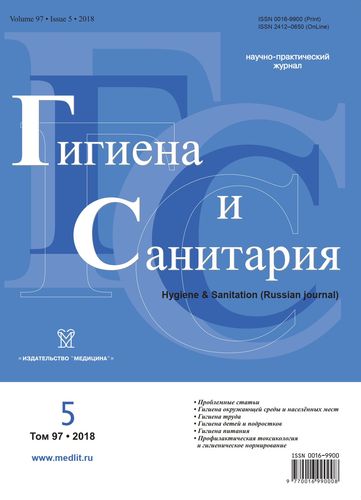Peculiarities of the toxic effect of diisononyl phthalate plasticizer phthalate on experimental models
- Authors: Grynchak V.A.1, Sychik S.I.1
-
Affiliations:
- Scientific-Practical Center of Hygiene
- Issue: Vol 97, No 5 (2018)
- Pages: 474-477
- Section: PREVENTIVE TOXICOLOGY AND HYGIENIC STANDARTIZATION
- Published: 20.10.2020
- URL: https://rjsocmed.com/0016-9900/article/view/640387
- DOI: https://doi.org/10.47470/0016-9900-2018-97-5-474-477
- ID: 640387
Cite item
Full Text
Abstract
Introduction. The purpose of the study was to determine the characteristics of the biological effect of diisononyl phthalate, a new plasticizer for polymer products.
Material and methods. Toxic properties of the compound have been studied in various ways of its entering in the organism of laboratory animals, local irritating, cumulative and skin-resorptive actions have been established, the potential ability of the compound to induce remote effects in experimental models in vivo/in vitro has been revealed.
Results and discussion. The obtained data show diisononyl phthalate do not pose a risk of the acute poisoning under intragastric, intraperitoneal, epicutaneous and inhalation modes of exposure, being incapable of inducing signs of the irritation of the skin and mucous membranes, is not allergic. With subchronic intragastric administration of diisononyl phthalate in doses from 10,000 to 100 mg/kg, the dose dependence of toxic effect and its ability to cause chronic polytropic poisoning of the action in the form of disturbance of the pattern of peripheral blood, calcium and phosphorus metabolism and changes in the functional state of internal organs are revealed. In the study of the reproductive toxicity against the background of the administration of the drug at a dose of 10,000 mg/kg, an increase in total postimplantation, embryonic and the postnatal mortality rate was established. Intragastric administration of diisononyl phthalate at the mentioned dose to female animals during pregnancy triggered the formation of multiple (combined), external and internal malformations of embryos that were single in response to a reduced dose of up to 100 mg/kg. Changes in the state of the reproductive function of males have not been established. In the study of mutagenic toxicity in the Ames test, the effect of the compound has not been established to lead to an increase in the number of revertant colonies, which indicates the lack of ability of diisononyl phthalate to induce point mutations.
Conclusion. The results of the studies showed that further study of the toxic effect of diisononylphthalate in chronic exposure and in vitro tests is necessary.
About the authors
Vitaly A. Grynchak
Scientific-Practical Center of Hygiene
Author for correspondence.
Email: grinchakva@gmail.com
MD, postgraduate student of the Scientific Practical Center of Hygiene, Minsk, 220012, Belarus.
e-mail: grinchakva@gmail.com
BelarusS. I. Sychik
Scientific-Practical Center of Hygiene
Email: noemail@neicon.ru
Belarus
References
- Grynchak V.A., Sychik S.I. Actual problems of safe handling of diisononyl phthalate. Proceedings of the Belarusian State University. Series: Physiological, biochemical and molecular basis of functioning of biosystems. 2016; 11 (2): 36-46. (in Russian)
- Grynchak V.A. Actuality of toxicological and hygienic assessment of diisononyl phthalate as a chemical substance disrupting the endocrine system. Collection of materials of the School of Young Scientists “Fundamentals of Healthy Nutrition and Ways to Prevent Alimentary-Dependent Diseases”, M.; 2016; 1: 66-71. (in Russian)
- Babich P.N., Chubenko A.V., Lapach S.N., Zhminko P.G. Calculation of the cumulation coefficient using modern information technologies. Modern problems of toxicology. 2004; 2: 53-60. (in Russian)
- Requirements for the formulation of experimental studies for the primary toxicological assessment and hygienic regulation of substances: Instruction No. 1.1.11-12-35-2004: approved. Ministry of Health Resp. BelaRussia on 14.12.2004. Minsk; 2004: 43. (in Russian)
- Galieva M.A., Nurpeisov T.T., Zhumabekova B.K., Kurmangalieva D.S., Zhanasova M.M. Evaluation of the efficiency of specialized nutrition for physiological parameters in subacute aerosol exposure in rubber technical production. Bulletin of KazNMU. 2013; 5 (1): 72-4. (in Russian)
- Beletskaya E.N., Onul N.M. Effect of zinc on the reproductive function of experimental animals. Microelements in medicine. 2014; 15 (2): 22-8. (in Russian)
- Guseva S.I., Avdeeva О.I., Makarova M.N., Shikov A.N., Pozharitskaya O.N., Karachinskaya I.V., Dyachuk G.I. Preclinical study of embryo-phytotoxical properties and influence on the generative function of a new phytodrug. Herald of the Mechnikov Saint-Petersburg State Medical Academy. 2009; 3 (32): 143-9.
- OECD guideline for testing of chemicals 471. Bacterial Reverse Mutation Test, (1997). Available at: http://www.oecd.org/chemicalsafety/risk-assessment/1948418.pdf (accessed 8 May 2014).
- Guide for the care and use of laboratory animals. Institute of laboratory research resourcens. National academy press. Washington, D.C. 1996; 1: 128.
- Harmful substances. Classification and general requirements of safety: GOST 12.1.007-76. - Enter. 01/01/1977. Minsk: BelGISS, 2008: 8. (in Russian)
- Berezovskaya I.V., Classification of chemicals by acute toxicity parameters for parenteral administration. Chemical and pharmaceutical magazine. 2003; 37 (3): 32-4. (in Russian)
- Argunov M.N. Veterinary toxicology with the basics of ecology. Lan: 2007; 160. (in Russian)
Supplementary files









